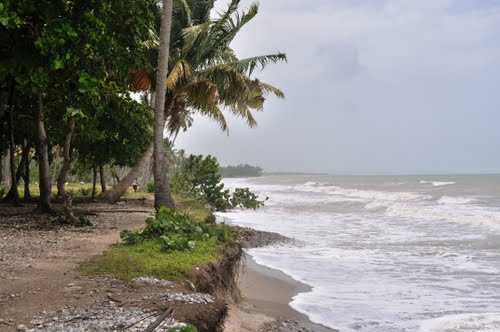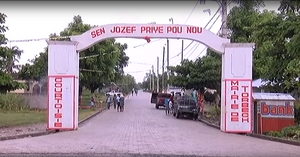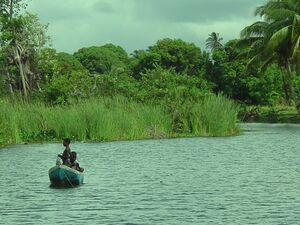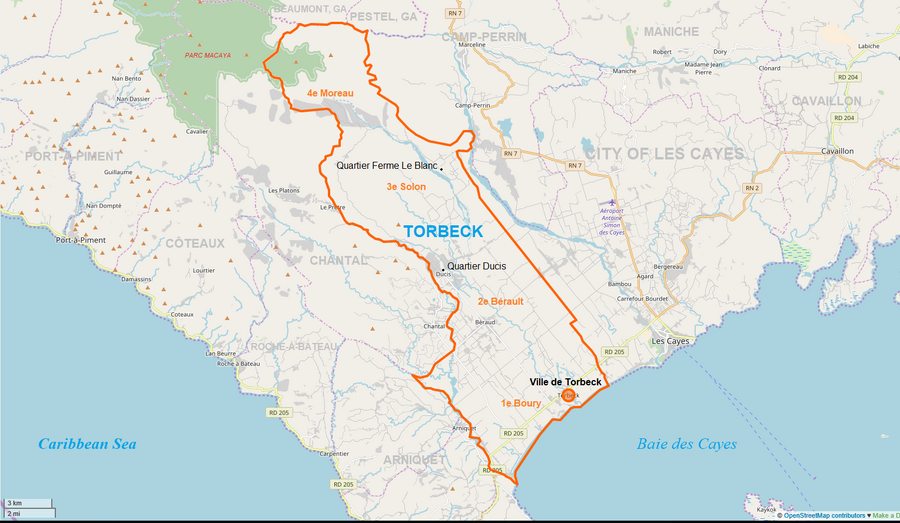"Chen gen kat pye, men li ka mache nan yon sèl chimen."
A dog has four legs, but it walks in only one path.
Torbeck (Kreyol: Tòbèk) is a commune in the Les Cayes Arrondissement, in the Sud department of Haiti. It has 69,189 inhabitants.

Quiet seaside town of Torbeck, Sud, Haiti


About[]
Torbeck, has four communal sections and two quarters. The city and the first communal section are coastal.
History[]
In the past, Torbeck was one of the most famous towns in the southern part of the country. A century earlier it had made considerable progress in the Les Cayes Borough. Historically it had played a role throughout the region. The commune had the name Moreau de Saint Remy since 1726 during the demolition of the primitive parishes. Torbeck was considered even more important than the city of Les Cayes because one said the city of Torbeck is the region where the company of Santo Domingo had its agents of administration. In 1787 the parish counted 600 whites, 860 freedmen 11,000 slaves, 81 sugar mills, 28 water mills 18 indigo farms and 100 coffee fields.
Several events also wove the memory of this zone. At first the revolt of the black named Samedi had exploded in the plain of Torbeck, in October 1802 a few days after the taking of d'Armes d'Auguste to Saint-Louis-du-Sud. On March 13, 1803 the French under the command of general Sarazin were obliged to barricade themselves in the church of St. Joseph of Torbeck. It should also be remembered that the conspiracy against the emperor James the First had begun on the Garata habitation at the inquest of Messeroux, the Torbeck Peace Court on October 8, 1806. Later in 1844 and 1848, Torbeck was the main home of the Southern Brigades. Finally in 1869 this commune was the theater of fierce struggles between the cacos and the pickets, the latter going to the defense of President Salnave. Note that it is in the city church that was buried the steward Maillard who made the colony prosper, it is also in this town that was centered for the first time a soccer ball. Finally it is the hometown: the writer of the act of independence Mr. Boisrond Tonnèrre, the father of Fabre Geffard from the habitation of Perigny, General Jacques Wagnac who commanded Les Cayes in 1903.
- The first citizen who represented Torbeck in the Chamber in 1817 was F. Dubreuil, who was appointed one its secretaries.
- In October 1802, a few days after Augustus took up arms at Saint-Louis-du-Sud, a revolt led by a black native called Samedi broke out in the plain of Torbeck. Smith, a white settler, his master, was murdered on his home. Samedi had under his command only 30 men armed with stones and sticks. General Laplume, who was in command in Les Cayes, marched against him with a detachment commanded by an officer from Torbeck named Elie Maury. Laplume flooded the Torbeck district with national guards and European troops; the plantations were decimated; the blood of the natives flowed in great streams. The revolt of Samedi was too late against Leclerc and only resulted in the carnage of his brothers who had favored his flight.
- On March 13, 1803, the French, commanded by General Sarrazin were pushed back from Welche-Taverny to Torbeck where Geffrard came to attack them from his camp in Gérard. Sarrazin, seeing himself surrounded, barricaded himself in the church. He was saved by the arrival of 700 men sent by Laplume to help.
Geography[]
Torbeck is located at 18.1646° N, 73.8110° W. According to the IHSI, this commune has a total land area of 189.48 square kilometers (73.16 square miles), of which, 139.73 sq.km (74%) is suburban, 45.94 sq.km (24%) is rural, and 3.81 sq.km (3%) is urban. It is bordered on the north by the town of Beaumont, on the northeast by the town of Pestel, on the east by the communes of Camp-Perrin and Les Cayes, on the south by the town of Saint-Jean-du-Sud, on the southwest by the city of Port-Salut, and on the west by the towns of Arniquet and Chantal. Torbeck has four communal sections and two districts. These sections include a total of 85 localities and 59 habitations.
Torbeck is the second most-populated municipality of the Borough of Les Cayes, which is in the department of the South. It is about 6 km 4 mi from the city of Les Cayes. In a general way the town offers a panorama of plains, plateaus, and valleys. The land area consists primarily of plains in the 1st and 2nd sections, foothills and valleys in the 3rd section, and mountains in the fourth. The greater part of town has a flat configuration with the most characteristic features. Indeed it is an extension of the vast Les Cayes Plain, the coastal strip located west of Les Cayes; a swamp that is well suited to rice growing. The mountainous areas are in the 3rd and 4th sections.
The law of April 25, 1817 placed the legal distance from this commune to the capital at 53 leagues.
Neighborhoods
| TOB | Torbeck | 78,603 | |||
|---|---|---|---|---|---|
| VTK | Ville De Torbeck | Urban | 2,584 | ||
| QDC | Quartier Ducis | Urban | 1,882 | ||
| QFL | Quartier Ferme de Leblanc | Urban | 780 | ||
| BRY | 1ère Section Boury | Rural section | 27,156 | Ca Louis, Carrefour Méridien, Cassagne-Finca, Chalette, Duverni, Formon, Godefroy, Grassette, Guillerme, Houck, Jauge, La Force, Mineur, Nan Goyave, Nan Redon, Poteau, Poterie, Praslin, Soulé, Welsh. | |
| BRL | 2ème Section Bérault | Rural | 22,032 | Bauzan, Bellevue, Béraud, Bois Landry, Borgella, Boulé, Bourdet, Burin, Delfosse, Digue-Monville, Dumortier, Dumusat, Durocher, Gaston, Gérard, Guilloux, Jonca, Labeye, La Frésilière, Laumont, Monvide, Perigny, Saint-Félix, Surin, Tuffet. | |
| SON | 3ème Section Solon | Rural section | 17,634 | Achille, Bézin, Billard, Billiard, Bois Pangrol, Canon, Carré, Chéramy, Dessources, Dubreuil, Ducis, Fond Vert, Gilgot, La Frésilière, Lagrou, Le Duc, Le Prêtre, Magnant, Monville, Possin, Régnier, Toro, Touya. | |
| MRE | 4ème Section Moreau | Rural Section | 7,593 | Deronceley, La Coste, Lamonge, Malval, Moreau. |
The following table gives a presentation of the communal sections with their different characteristics.
| Communal sections | Position | Dominant relief | Climate | Number of habitations | Number of localities | Area in km² |
|---|---|---|---|---|---|---|
| 1 st Boury section | Seaside | Plain | Normal | 8 | 38 | 42.71 |
| 2 nd section Berreau | inland | Plain | Normal | 2 | 12 | 49.99 |
| 3 rd Solon section | interior | Foothills | Normal | 33 | 14 | 48.98 |
| 4 th Moreau section | inland | Mountain | Fresh | 16 | 21 | 60.18 |
Demography[]
According to some geographical redistributions, the municipality of Torbeck offers an irregularly evolving demographic. Its inhabitants bear the name of Torbeckois.
| Year | Population | +/- |
|---|---|---|
| 1890 | 8,000 | |
| 1950 | 36,491 | +356% |
| 1971 | 56,144 | +54% |
| 1982 | 35,349 | -37% |
| 2003 | 60,012 | +70% |
| 2009 | 69,189 | +15% |
| 2015 | 78,602 | +12% |
94% of the population lives in rural areas, while 6% in urban areas.
The municipality of Torbeck has 12,095 households. These households live largely in old buildings consisting mostly of thatched cottage covered with vetiver straw in some places can also find sheet metal roofs. Houses made of masonry are rare and reserved for an elite of privileged (officials, traders ...) and administrative buildings. It is also worth noting some extension areas that are characterized by well-built modern houses such as the city of Torbeck, Formont, Ducis, Lauzon, Gerard, Poteau, Houck, and Desgrottes.
Torbeck Plain[]
The habitations on the beautiful Torbeck plain are generally well enclosed. Formerly, there were the rural sections of the Lower and Upper Plains. Cultivation is varied there: beautiful cane fields hang out from the mountains on the slope of the Coteaux. The property is divided up there. The Ravine des Mornes and the Torbeck River water the plain of Torbeck and that of Les Cayes, taking their source from the heights of the Platons and flow into Torbeck.
Ville de Torbeck[]
The air in the village is cool and fresh, placed between two rivers bounding the sea. It has a main street half a league long, and lined with sleek little houses. The harbor is shallow but very full of fish.
The two rivers are l'Estère, with warm still water, and the Grande Rivère; wide, deep, and full of fish, especially crayfish.
Climate[]
The average temperature of the zone is 21°C 70°F with a maximum of 27.64 82°F degrees in August. With regard to the rainy season, the commune is not very favored. The most significant rainfall is recorded during the months of May to October, however in recent years there has been very great rainfall irregularity.
Water Resources[]

Torbeck River
At the commune level the water resources are relatively impotant. Many rivers crisscross the town. The Redon River crosses Bois Landry and the community of Redon; that of Labattie, Larnage, Poteau, Desrodieres, and Bourry water the first section of Bourry, and the river penetrates the interior of the town of Torbeck; the Rivière Acul which serves as a border to the towns of Arniquet and Chantal waters Bourry, Béraud and Solon; that of Bras de Gauche waters the fourth section of Moreau; the Rivière Bouda Mouillé runs through Gauvin, Charlette and Rock, when dry and when mad it goes to the 4th Moreau section. To this list is added the sources of Desgrottes, Gauvin, Poteau; Ravine Sable, l'Estère, Poteaux, Desrodières at the Bourry level and the dry one on the Major dwelling belonging to the 3rd section of Solon.
But the most important of these rivers are the South River and the Torbeck River. The latter has its source in the heights of the Platons and sprinkles particularly, 1st Bourry and 2nd Beraud.
Vegetation[]
The municipality of Torbeck as a whole is covered by a fairly important training that combines with farming or livestock systems to form highly profitable agro-forestry units.
This training includes both local and exotic species. The exotic species introduced by the reforestation or soil conservation programs launched by PADF or ORE, Haiti verte, are cedar, acasia, eucalyptus, cassia, whitewood and fruit species such as grafted French mango and some varieties of citrus.
Local species dominate the coconut tree and the true tree and certain other species such as mango, avocado, almond, ash, hourglass, elm wood, mahogany and oak. The thicket is mostly young trees, upright shrubs and branches. The agroecological situation of the region greatly influences plant distribution.
Ecological agro - zone
Depending on the characteristics of the environment, the municipality of Torbeck can be divided into four agro-ecological zones.
·The low-lying, low-rainfall coastal plain area where rice, mazonbelle and banana are grown, in this zone the vegetation is mainly dominated by the coconut tree and the breadfruit tree.
· The average altitude dry mountain area where one grows food and cereals, the vegetation is more or less diversified by the presence of other forest and / or fruit species.
·The wet humid mountain area mainly is mainly located at the 3rd and 4th sections in the high altitudes. LaSource, Morne Gerard, and Toro are where some of the market gardeners cultivate yams and cereals.
· The very humid mountain area where market gardening flourishes, such as carrot, beetroot, cabbage and thyme.
Economy[]
Agriculture is the basis of the Torbeck economy; In order of importance, maize, rice, millet and black beans are found in the lowland areas. In the mountains, tuber cultivation {sweet potatoes, potatoes, cassava, taro, yam} largely dominates. The region has some favorable conditions such as, very diversified agricultural production, topography relatively favorable to agriculture, food production and important cereal, and the existence of several PPIs (Small Irrigated Perimeters).
Fishing is also dominant on the coast.
Concerning the economic and financial establishments, they are non-existent in the municipality of Torbeck. There is a credit union.
Infrastructure[]
Education

Education center; Torbeck, SD, Haiti
The Ministry of National Education of Youth and Sports is not represented in the municipality of Torbeck. For schools, at the Kindergarten level there are two schools and at Primary level, schools including five public, dozens of private and three congregational. At the secondary level, four schools including one public and three private were inventoried in the commune.
Health
The Ministry of Public Health and Population is not represented in the Municipality of Torbeck. For health facilities, there are two clinics and a health center. In addition, five nurses and eight auxiliaries assist the sanitary service in the commune.
Utilities
As for water availability, nine rivers, eleven springs and 4 ponds were counted at the commune level. With respect to other water features, dozens of single wells, artesian wells, and pumps were recorded. Apart from the partially electrified city of Torbeck, kerosene remains the main mode of lighting in the municipality, with rare generators and solar panels being held by services and a few private ones. The city center, the 1st and the 2nd communal sections have electricity. This service is provided by the Electricity of Haiti (EDH). The power frequency is 56 hours / week.
Security
With regard to the Administrative and Judicial Infrastructures, the municipality has a Court of Peace and a Sub-Commission. There is a police custody room.
The court of peace falls under the jurisdiction of the civil court of Les Cayes.
Administration[]

Torbeck
The city of Torbeck does not enjoy the privilege of having representations of the autonomous central administration. Theoretically, the role of the administration in a city is to enable this city to meet the needs and requirements of the people in its area of local and regional influence.
Culture[]
Religion
Nearly 69 temples of all beliefs have been enumerated in the commune. These temples are divided according to these faits: Catholic, Episcopal, Baptist, Adventist, Pentecostal, Wesleyan, Jehovah's Witness.
The church is under the patronage of Saint Joseph. It is in this church that the steward Maillart was buried, whose good understanding with Larnage made the colony of Saint-Domingue prosper for a long time.
Famous people
Several famous men were born in Torbeck. Nicolas Geffrard, the father of the president of this name, was born on the Perigny habitation in 1761. He died in Les Cayes on May 31, 1806. His body rests in the citadel of the Platons. His foot is embedded in the wall. Boisrond Tonnerre, author of the Act of Independence and the proclamation of January 1, 1804, claimed to be born in Torbeck in 1776. However, he was born on the Galée habitation, located in the commune of Cayes.
"To draw up the act of Independence, he cried, we need the skin of a blanc for parchment, his skull for writing-desk, his blood for ink, and a bayonet for pen." Bloody words which, at the time, aroused general admiration. Battalion Commander Samedi Smith, who also distinguished himself during the War of Independence, was born there. Hérard Dumesle, famous tribune was also born there on June 16, 1784. He was expelled from the Chamber on August 14, 1833. He represented the commune of Les Cayes. He reappeared in the House in 1839 and presided over it, and contributed powerfully to the overthrow of President Boyer's government. The city of Les Cayes awarded him a gold medal for his good conduct in the Chamber.
General Jean-Jacques Wagnac, who commanded the district of Les Cayes in 1813 was a child of Torbeck. He was born in 1759 and died in Les Cayes on September 22, 1813. Rivière-Hérard who was president of Haiti following the of 1843 that he had provoked, was also born Torbeck. Jean-Jacques Aca was also born there.
Organizations
With regard to the Parties and Organizations, there are two representations of Political Parties, two Popular Organizations, six farmers' groups, two Women's Groups and three Non-governmental organizations.
Communication
The municipality has no radio station, no newspaper / magazine or television station.
Leisure
As for Leisure, there is no library, museum, theater mor cinema in Torbeck. The only sport practiced is football (soccer). Two night clubs operating on Sundays and 21 gaguères were listed in the Commune. One finds at the level of the cultural heritages a fort (the fort of the platons). It should be noted that the Commune through its various chapels celebrates a good number of Patron Saints. The parish of Torbeck was created in 1719 under the patronage of St. Joseph.
Of note is Carrefour Gauvin, a former military post, and Grotte Moreau, a cave located in the north of the commune.
The Fort des Platons is one of about twenty military works built on the territory of Haiti after independence in 1804: this defensive system was directed against a possible return of the French, former masters of the colony of Santo Domingo. The Fort des Platons was built under the direction of General Nicolas Geffrard, father of President Fabre Geffrard. The ruins of the fort are located in the district of Ducis.
Les Platons[]
The Citadel of Platons is a huge fortress erected 600 meters above sea level overlooking the south coast of Haiti. Day trips depart from the town of Les Cayes to visit the citadel. Guided tours take you into the mountainous rainforest below the fortress. The whole area is full of picturesque nature and sea views.
After a pass through Ducis, arrive at the village of Dubreuil. When you are in Dubreuil, the citadel is about a two to three hour walk up a steep path that offers breathtaking scenery. Continue on the same path through Formond. Enter Macaya National Park and follow the signs for Platons Citadel.
The Platons or Parades are placed in front of the Macaya. The Ravine des Mornes, which waters the Torbeck plain, takes its source in the heights of the Platons. From these fortified heights, the eye dominates the entire Cayes plain, and the Orange trees, between Saint Louis and Cavaillon.
- In 1792, the slaves of the Platon mountains had marched to support the rights of men of color. This insurrection became formidable, and kept the whites in Les Cayes in constant alarm. The blacks, led by one of theirs named Armand, occupied steep positions, covered with wood, crossed by deep gorges,
along the plain of the valley.
Governor Blanchelande went in person to the foot of the Platons, and presented himself as a peacemaker to the blacks who refused to surrender. On August 6, Blanchelande conducted three columns of troops against them. He established his neighborhood general opposite the foot of the Platoons, near the insurgent camp. where stood Armand, The blacks, a number of 10,000 occupied an area of 6 leagues; they only had 900 rifles, pikes and stones as weapons. In the afternoon, the insurgents assailed the front and the flanks the first white colonnades, commanded by Deschet. This one had to retreat under a hail of bullets and stones, crossed in disorder the highest peak of the Platons, the famous parade bordered by precipices, called the Dompte-Mulatres. His division almost perished there: the prisoners were slaughtered.
The second white column, commanded by Thiballien - unaware that the first had been annihilated - attacked the 7 negroes hiding themselves behind the trees and the rocks, and threw down the whites on all sides with a fiery plunging fire. The whites were forced to abandon the battlefield after losing Lt. Col. Doyle of the 88th.
References[]
Plaine de Torbeck: quand le béton remplace les denrées alimentaires -Fobert François (2016) [1]
Michael Vedrine

